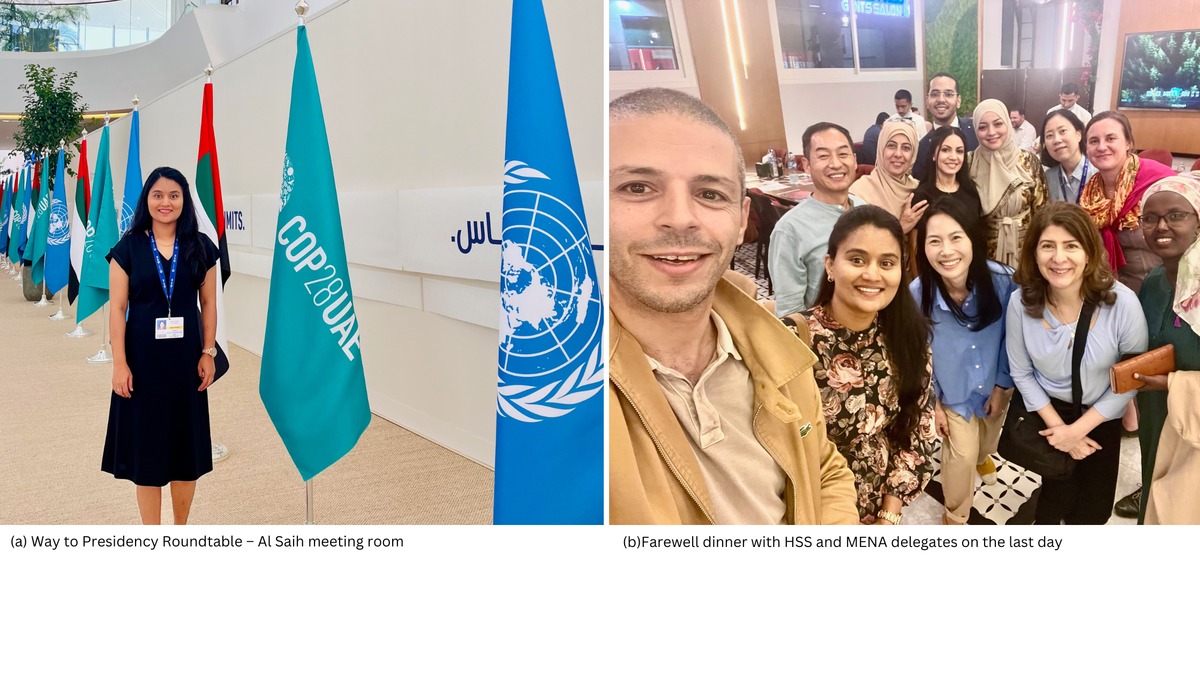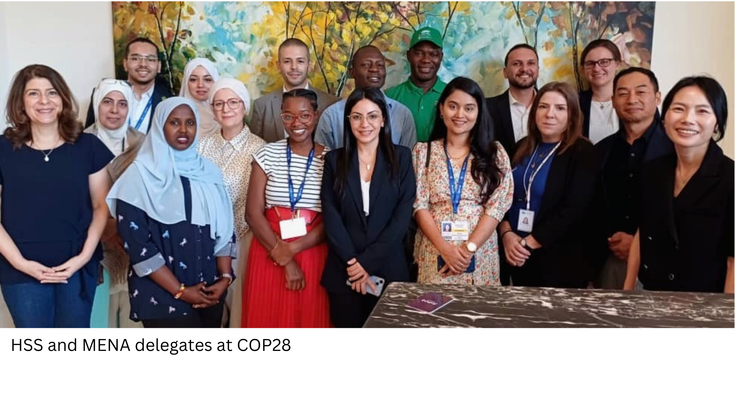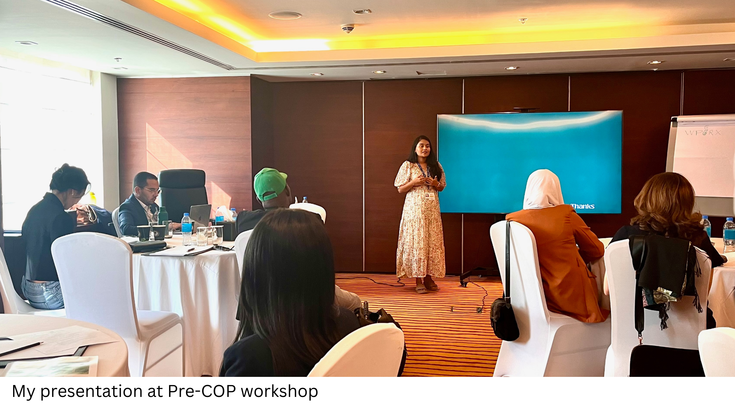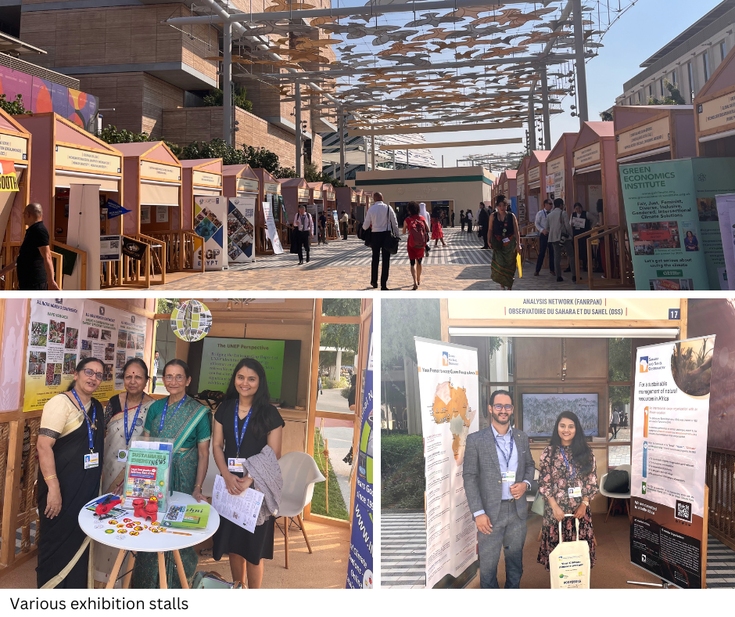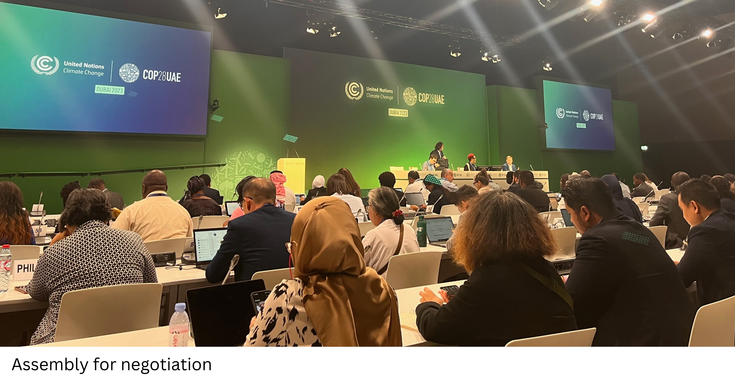The much awaited 28th meeting of the Conference of the Parties (COP) to the UNFCCC in Dubai was recently concluded. At COP28, world leaders were joined by about 85,000 participants to brainstorm solutions to address the global climate emergency. Hanns Seidel Stiftung (HSS) sent an international delegation of experts from around the world to COP28 to share ideas and solutions. From India, Dr. Deepa MPM, a water and agriculture scientist, participated in the said delegation from November 30th to December 6th, 2023. In the following text, she presents her experience, learnings, and key takeaways for enhanced climate action in India:
News
A Delegate's Report
COP28: Beginning of the End of the Fossil Fuel Era?
The Global Climate Conference widely known as COP28 was organized by the United Nations Framework Convention on Climate Change (UNFCCC) in Dubai, UAE from November 30th to December 12th, 2023. It was a great experience to be part of the 6-member delegation sent by HSS to the world’s only multilateral decision-making forum. The delegation was led by Dr Lara Beer, Head of Project GMACC, Hanns Seidel Foundation Namibia.
I arrived in Dubai on November 30th, 2023. I thank HSS for making my journey from Bangalore to the hotel of my stay in Dubai pleasant and hassle free. UNFCCC provided all facilities to the participants in a well-planned manner. Delegates were provided with the metro card for smooth travel all over Dubai and a souvenir, water bottle labelled COP28.
Pre-COP Workshop
On December 1st, I was briefed about COP28 delegation programme and completed the requisite procedures. The next day, I attended the pre-COP workshop for THINK Global delegation and MENA delegation, held at the AVANI Deira Hotel Dubai, by HSS. The workshop was very interactive and provided complete information about the daily session themes, partners, pavilions, ideas, and negotiation activities at COP28. It also rendered reflections on the previous COP experiences for better guidance, clarity and understanding.
Experiencing COP28
From December 3rd to 5th, I attended pavilions, exhibitions, events, high level meetings and negotiations.
Indian Ministry of Environment, Forest and Climate Change (Ozone Cell and HSMD) organized several sessions at the India Pavilion. I could attend some of them. There was a session about India’s approach towards Sustainable Cooling. It focused on implementation framework of the India’s Cooling Action Plan (ICAP) and synergies with the HCFCs phaseout, Kigali amendment and initiatives for implementation towards sustainable cooling and thermal system market studies along with improvement needs. There was a session on the ‘Role of Resource Efficiency and Circular Economy in Decarbonisation’, which focused on how the green transition can be achieved through resource efficiency, circular economy and industry coalition. The session on ‘Women & Water’ gave insights into how India’s women are steering WASH program, status of tap water coverage in rural India, saturation approach under the Jal Jeevan Mission, impact of water and sanitation with case studies.
Korean pavilion hosted a discussion on the ‘Green Climate Fund’. It made me understand that why an easy access to climate finance is the need of the hour and to what extent the vulnerable countries are exposed to it. In the same pavilion the Kookmin University and HSS Korea made a presentation on ‘Fostering Global Climate Talent: Towards Mainstreaming Climate Action Initiatives’. The session addressed principles of UNFCCC (Article 3) advocating common but differentiated responsibilities and respective capabilities for climate action.
The Children and Youth Pavilion was a unique platform where youngsters voiced their ideas and understandings of addressing climate change issues. I had an opportunity to witness few more sessions at this pavilion such as: Climate Justice from the point of view of children, Spotlighting youth perspectives on the path to climate resilience, and Youth adaptation to climate change: Challenges and solutions.
Exhibitions
Exhibition stalls were allotted at COP28 to the organizations, universities, and individuals involved in addressing climate change by their actions.
There was a stall by an Indian NGO, All India Women Conference. Their works aim at empowering women and fighting climate change. Cornell University stall was about its 2030 Project – A Cornell Climate Initiative, to mobilize its faculty to drive tangible solutions over the decisive decade for climate actions focusing on food and farms, energy, societies and materials of the future.
The stall by Partnership for Observation of the Global Ocean (POGO) in association with ‘Plymouth Marine Laboratory’ (PML) gave a detailed review on why oceans matter in climate negotiations and blue carbon economy.
I also visited a stall by the Food, Agriculture and Natural Resources Policy Analysis Network (FANRPAN). They along with Observatories Du Sahara Et Du Sahe (OSS) are working extensively on climate fund and sustainable management of natural resources (Land, water, climate and biodiversity) in local African regions. They are also focusing on development and cultivation of climate change resistant rice varieties in the African countries.
Negotiations
Negotiations sessions were restricted only to Parties and we as observers were not allowed in many of those sessions. I attended a negotiation session on ‘Shram el-Sheikh Joint Work on Implementation of Climate Action’. A comprehensive and interactive session, it provided the country representatives with an opportunity to express their agreement or disagreement with respect to certain aspects of a draft policy, which may or may not be applicable and acceptable in their country. The whole session of one and half hour was devoted to painstakingly discussing a single paragraph. That showed the complex and multifaceted nature of negotiations that try to take care of the concerns of each country.
High Level Roundtable
This was the exclusive session for the ministers of member countries to discuss Renewable and Energy Efficiency. I had an opportunity to witness it. The discussion highlighted what role hydrogen can play in carbon abatement, if used and applied in a sustainable manner. Ministers exchanged their views on the scope, context, extent and utilization of hydro power in their respective countries.
Personal Level Learnings and Networking
My participation in the COP28 helped me understand the global perspectives of climate actions. Especially in the areas of climate fund, water resources management, renewable energies, gender equality and youth in climate change. Now I can better assess the regional perceptions of the country officials, research organisations, NGOs, policy makers and other stakeholders, when it comes to dealing with climate change. Participation in COP28 also provided me with opportunities to develop contacts with individuals and organisations working for a common cause of dealing with climate change with different approaches. This is going to help me collaborate and work to address climate change issues facing India.
Key Takeaways for Policy Community
Each moment spent at COP28 was full of learnings. There were some important takeaways that need to be shared with the policy community and public at large. I present some of them here:
- The leaders, governments and individual entities should understand that a prerequisite for successful climate actions is collaborative planning.
- Interactions and co-ordination between different government departments within and between the countries are needed for breaking silos and efficient policies.
- Policies and finance are complementary. Finance is needed to meet policy objectives. Given the fact that public finance alone cannot meet the climate financing needs, it is important to combine public and private capital.
- Blended finance landscape of India must be ratcheted up to plug the funding gaps in achieving India’s international climate commitments.
- Lot of funding goes to developmental programs. It should also be made available for sustainable development activities.
- From top to bottom, the country’s climate institutions must be sensitized to the need for blended finance, climate justice and importance of co-ordinated efforts.
